AEG-Electrolux SANTO Z 9 18 40-5I User Manual
SANTO Z 9 18 40-5 i
Integrating Fridge-Freezer Réfrigérateur-congélateur intégrable Integrierbares Kühl-Gefriergerät
Operating and Installation instruction Notice d’utilisation
Gebrauchsund Einbauanweisung

Dear customer,
Before placing your new refrigerator/freezer into operation please read these operating instructions carefully. They contain important information for safe use, for installation and for care of the appliance.
Please keep these operating instructions for future reference. Pass them on to possible new owners of the appliance.
These operating instructions are for use with several technically comparable models with varying accessories. Please observe the notes which apply to your model.
Notes which are important for your safety or for the proper functioning of the appliance are stressed with a warning triangle and/or with signal words (Warning!, Caution!, Attention!). Please observe the following carefully.
Supplementary information regarding operation and practical applications of the appliance appear after this symbol.
Tips and notes concerning economical and environmentally sound use of the appliance are marked with the flower.
The operating instructions contain instructions for the correction of possible malfunctions by the user in the section "What to do if ...". If these instructions should not be sufficient, our customer service department is always available to you.
2

Contents |
|
Safety . . . . . . . . . . . . . . . . . . . . . . . . . . . . . . . . . . . . . . . . . . . . . . . . . . . . . |
.4 |
Disposal . . . . . . . . . . . . . . . . . . . . . . . . . . . . . . . . . . . . . . . . . . . . . . . . . . . . |
6 |
Appliance Packaging Information . . . . . . . . . . . . . . . . . . . . . . . . . . . . . . . |
6 |
Disposal of old Appliances . . . . . . . . . . . . . . . . . . . . . . . . . . . . . . . . . . . . |
6 |
Remove transport safeguard . . . . . . . . . . . . . . . . . . . . . . . . . . . . . . . . . . |
6 |
Shelf holders . . . . . . . . . . . . . . . . . . . . . . . . . . . . . . . . . . . . . . . . . . . . . . . . |
7 |
Installation . . . . . . . . . . . . . . . . . . . . . . . . . . . . . . . . . . . . . . . . . . . . . . . . .7 Installation Location . . . . . . . . . . . . . . . . . . . . . . . . . . . . . . . . . . . . . . . . . .7 Your refrigerator needs air . . . . . . . . . . . . . . . . . . . . . . . . . . . . . . . . . . . . .8 Housing dimensions . . . . . . . . . . . . . . . . . . . . . . . . . . . . . . . . . . . . . . . . . .8
Electrical Connection . . . . . . . . . . . . . . . . . . . . . . . . . . . . . . . . . . . . . . . . .8 Prior to Initial Start–Up . . . . . . . . . . . . . . . . . . . . . . . . . . . . . . . . . . . . . .8
Operating and indicator panel Fridge . . . . . . . . . . . . . . . . . . . . . . . . . .9
Temperature setting buttons . . . . . . . . . . . . . . . . . . . . . . . . . . . . . . . . . .9 Air filter . . . . . . . . . . . . . . . . . . . . . . . . . . . . . . . . . . . . . . . . . . . . . . . . . . .10 Interior accessories . . . . . . . . . . . . . . . . . . . . . . . . . . . . . . . . . . . . . . . . .13 Longfresh 0°C compartment . . . . . . . . . . . . . . . . . . . . . . . . . . . . . . . . .14 Humidity control . . . . . . . . . . . . . . . . . . . . . . . . . . . . . . . . . . . . . . . . . . .14 Drawer divider . . . . . . . . . . . . . . . . . . . . . . . . . . . . . . . . . . . . . . . . . . . . .15 Correct storage . . . . . . . . . . . . . . . . . . . . . . . . . . . . . . . . . . . . . . . . . . . . .16 Switching off the appliance . . . . . . . . . . . . . . . . . . . . . . . . . . . . . . . . . .19
Operating and indicator panel Freezer . . . . . . . . . . . . . . . . . . . . . . . . .20
Temperature setting buttons . . . . . . . . . . . . . . . . . . . . . . . . . . . . . . . . .20 Freezing and storing frozen food . . . . . . . . . . . . . . . . . . . . . . . . . . . . .23 Preparation of Ice Cubes . . . . . . . . . . . . . . . . . . . . . . . . . . . . . . . . . . . . .24 Freezing Calendar . . . . . . . . . . . . . . . . . . . . . . . . . . . . . . . . . . . . . . . . . . .24 Defrosting . . . . . . . . . . . . . . . . . . . . . . . . . . . . . . . . . . . . . . . . . . . . . . . . .24 Cleaning and Care . . . . . . . . . . . . . . . . . . . . . . . . . . . . . . . . . . . . . . . . . .25 Energy Saving Tips . . . . . . . . . . . . . . . . . . . . . . . . . . . . . . . . . . . . . . . . . .26
What to do if . . . . . . . . . . . . . . . . . . . . . . . . . . . . . . . . . . . . . . . . . . . . . .27 Correcting Malfunctions . . . . . . . . . . . . . . . . . . . . . . . . . . . . . . . . . . . . . .27 Changing the light bulb . . . . . . . . . . . . . . . . . . . . . . . . . . . . . . . . . . . . . .28
Regulations, Standards, Guidelines . . . . . . . . . . . . . . . . . . . . . . . . . . .28
3

 Safety
Safety
The safety aspects of our refrigerators/freezers comply with accepted technical standards and the German Appliance Safety Law. Nevertheless, we consider it our obligation to make you aware of the following safety information:
Intended use
•The refrigerator is intended for use in the home. It is suitable for the cooling, freezing and storing of frozen food, as well as for making ice. If the appliance is used for purposes other than those intended or used incorrectly, no liability can be accepted by the manufacturer for any damage that may be caused.
•Alterations or changes to the freezer are not permitted for reasons of safety.
•If you use the refrigerator in a commercial application or forpurposes other than the cooling, freezing or frozen storage of foods,please observe all valid legal regulations for your application.
Prior to initial start–up
• Check the refrigerator for transport damage. Under no circumstance should a damaged appliance be plugged in! In the event of damage, please contact the vendor.
Refrigerant
The refrigerant isobutane (R600a) is contained within the refrigerant circuit of the appliance, a natural gas with a high level of environmental compatibility, which is nevertheless flammable.
•During transportation and installation of the appliance, be certain that none of the components of the refrigerant circuit become damaged.
•If the refrigerant circuit should become damaged:
–avoid open flames and sources of ignition;
–thoroughly ventilate the room in which the appliance is situated.
Safety of children
•Packaging (e.g. wraps, polystyrene) can be dangerous for children. There is a risk of suffocation! Keep packaging material away from children!
•Please make old appliances unusable prior to disposal. Pull out the mains plug, cut off the mains cable, break or remove spring or boltcatches, if fitted. By doing this you ensure that children cannot lock themselves in the
4

fridge when playing (there is risk of suffocation!)or get themselves into other dangerous situations.
•This appliance is not intended for use by persons (including children) with reduced physical, sensory or mental capabilities, or lack of experience and knowledge, unless they have been given supervision or instruction concerning use of the appliance by a person responsible for their safety.
Children should be supervised to ensure that they do not play with the appliance!
Daily Operation
•Containers with flammable gases or liquids can leak at low temperatures. There is a risk of an explosion! Do not store any containers with flammable materials such as, for example, spray cans, fire extinguisher refill cartridges etc in the refrigerator/freezer.
•Bottles and cans must not be placed in the freezer compartment. They can burst when the contents freeze, high carbonate content drinks can even explode! Never store lemonade, juices, beer, wine, sparkling wine etc. in the freezer compartment. Exception: high alcohol content spirits can be stored in the freezer compartment.
•Do not put ice creams or ice cubes in the mouth immediately after removal from the freezer compartment. Very cold ice can freeze to the lips or tongue and cause injury.
•Do not touch frozen food with wet hands. Your hands could freeze to the food.
•Do not operate any electrical appliances in the refrigerator/freezer (e.g. electric ice cream makers, mixers etc.).
•Before cleaning the appliance, always switch off the appliance and unplug it, or pull the house fuse or switch off the circuit breaker.
•When unplugging always pull the plug from the mains socket, do not pull on the cable.
In case of malfunction
•If the a malfunction occurs on the appliance, please look first in the "What to do if ..." section of these instructions. If the information given there does not help, please do not perform any further repairs yourself.
•Refrigerators/freezers may only be repaired by qualified service engineers. Improper repairs can give rise to significant hazards. If your appliance needs repairing, please contact your specialist dealer or our Customer Service.
5

Disposal
Appliance Packaging Information
All materials are environmentally sound! They can be dumped or burned at an incinerating plant without danger!
About the materials: The plastics can be recycled and are identified as follows:
>PE< for polyethylene, e.g. the outer covering and the bags in the interior. >PS< for polystyrene foam, e.g. the pads, which are all free of chlorofluorocarbon.
The carton parts are made from recycled paper and should be disposed of at a waste-paper recycling collection location.
Disposal of old Appliances
For environmental reasons, refrigeration appliances must be disposed of properly. This applies to your old appliance, and - at the end of its service life - for your new appliance as well.
Warning! Before disposing of old appliances make them inoperable. Remove plug from mains, sever the power cable, remove or destroy any snap or latch closures. This eliminates the danger that playing children lock themselves into the appliance (danger of suffocation!) or place themselves into other life-endangering situations.
Disposal:
•The appliance may not be disposed of with domestic waste or bulky refuse.
•The refrigerant circuit, especially the heat exchanger at the back of the appliance, may not be damaged.
•The symbol  on the product or on its packaging indicates that this product may not be treated as household waste. Instead it shall be handed over to the applicable collection point for the recycling of electrical and electronic equipment. By ensuring this product is disposed of correctly, you will help prevent potential negative consequences for the environment and human health, which could otherwise be caused by inappropriate waste handling of this product. For more detailed information about recycling of this product, please contact your local city office, your household waste disposal service or the shop where you purchased the product.
on the product or on its packaging indicates that this product may not be treated as household waste. Instead it shall be handed over to the applicable collection point for the recycling of electrical and electronic equipment. By ensuring this product is disposed of correctly, you will help prevent potential negative consequences for the environment and human health, which could otherwise be caused by inappropriate waste handling of this product. For more detailed information about recycling of this product, please contact your local city office, your household waste disposal service or the shop where you purchased the product.
Remove transport safeguard
The appliance and the interior fittings are protected for transport.
•Pull off the adhesive tape on the left and right side of the door.
•Remove all adhesive tape and packing pieces from the interior of the appliance.
6
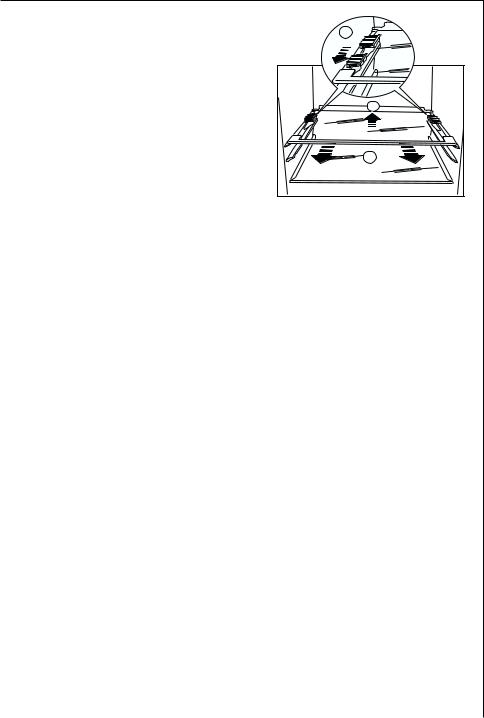
Shelf holders
Your appliance is equipped with shelf retainers that make it possible to secure the shelves during transportation. To remove them proceed as follows:
Move the shelf retainers in the direction of the arrow, raise the shelf from the rear and push it forward until it is freed and remove the retainers.
Installation
A |
B |
C |
Installation Location
The appliance should be set up in a well ventilated, dry room.
Energy use is affected by the ambient temperature. The appliance should therefore
–not be exposed to direct sunlight;
–not be installed next to radiators, cookers or other sources of heat;
–only be installed at a location whose ambient temperature corresponds to the climate classification, for which the appliance is designed.
The climate classification can be found on the serial plate, which is located at the left on the inside of the appliance.
The following table shows which ambient temperature is correct for each climate classification: each climate classification:
Climate classification |
|
for an ambient temperature of |
|
|
|
|
|
|
SN |
|
+10 to +32 °C |
|
|
|
N |
|
+16 to +32 °C |
|
|
|
ST |
|
+18 to +38 °C |
|
|
|
T |
|
+18 to +43 °C |
|
|
|
If installation next to a source of heat is unavoidable, the following minimum clearances must be maintained at the sides of the appliance:
–for electric cookers 3 cm;
–for oil and coal fired ranges 30 cm.
If these clearances cannot be maintained a heat insulating pad is required between the cooker and the refrigeration appliance.
If the refrigeration appliance is installed next to another refrigerator or freezer a clearance of 5 cm at the sides is required, in order to prevent the formation of condensation on the outside of the appliance.
7
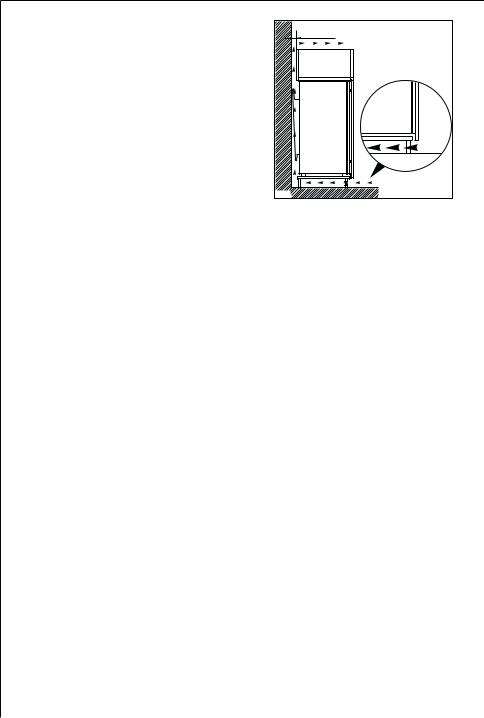
Your appliance needs air
For safety reasons, minimum ventilationmust be as shown Fig.
Attention: keep ventilation openings clear of obstruction;
Housing dimensions
Height |
1780 mm |
Depth |
550 mm |
Width |
560 mm |
50 mm |
min. |
200cm2 |
|
|
min. |
|
200cm2 |
D567 |
|
Electrical connection
Before initial start-up, refer to the appliance rating plate to ascertain if supply voltage and current values correspond with those of the mains at the installation location.
e.g.: |
AC |
220 ... |
240 V |
50 Hz or |
|
220 ... |
240 V~ |
50 Hz |
|
(i.e. 220 to 240 volts alternating current, 50 Hertz) The rating plate is inside the appliance on the left.
A correctly installed, earthed socket is required for the electrical supply. The supply must have a fuse rating of at least 10 Amps.
If the socket is not accessible once the appliance is built in, the electrical installation must include suitable means of isolating the appliance from the mains (e.g. fuse, cut-out, current trip or similar with a minimum contact separation of 3 mm).
Attention: If the supply cord is damaged, it must be replaced by a special cord available from the manufactured or its service agent.. Please contact your dealer or our customer service department for repairs.
Prior to Initial Start–Up
•Please clean the appliance interior and all accessories prior to initial startup (see section: “Cleaning and Care”).
8
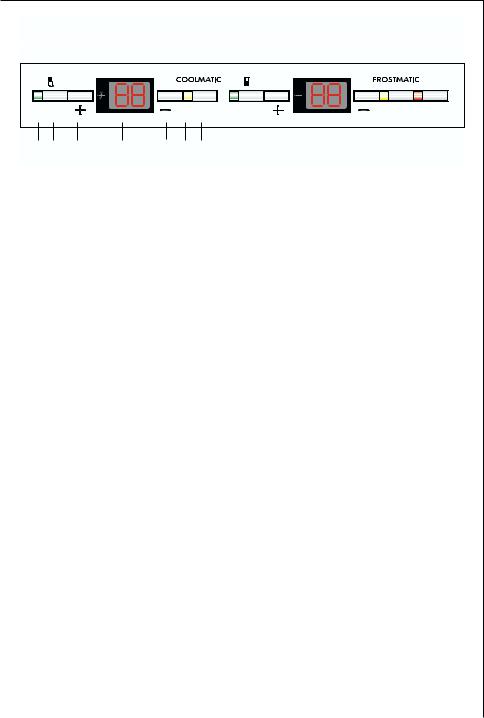
Operating and indicator panel Fridge
|
|
|
|
°C |
TURBO |
°C |
|
|
|
|
°C |
|
|
°C |
ALARM OFF |
||
ON/OFF |
|
|
|
|
ON/OFF |
|
|
|
A |
B |
C |
D |
E |
F |
G |
|
|
A. Mains pilot indicator (green)
BFridge button ON/OFF
CTemperature setting button (for warmer temperatures)
DTemperature display
ETemperature setting button (for colder temperatures)
FTURBOCOOLMATIC function "on" indicator (yellow)
GTURBOCOOLMATIC button
Temperature setting buttons
The temperature is adjusted using the „C“ and „E“ buttons. These buttons are connected to the temperature display.
•The temperature display is switched over from the display of the ACTUAL temperature (Temperature display is illuminated) to the display of the DESIRED temperature (Temperature display flashes) by pressing one of the two buttons, „C“ or „E“ .
•Each time one of the two buttons is pressed again the DESIRED temperature is adjusted by 1 °C. The DESIRED temperature must be reached within 24 hours.
If neither button is pressed, the temperature display automatically switches back after a short period (approx. 5 sec.) to the display of the ACTUAL temperature.
DESIRED temperature means:
The temperature that has been selected for inside the fridge. The DESIRED temperature is indicated by flashing numbers.
ACTUAL temperature means:
The temperature display indicates the current temperature inside the fridge. The ACTUAL temperature is indicated with illuminated numbers.
9
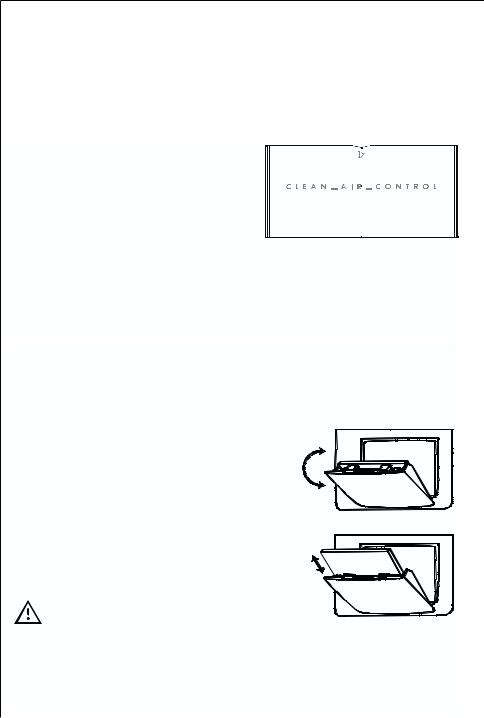
Temperature display
The temperature display can indicate several pieces of information.
•During normal operation, the temperature currently present in the fridge (ACTUAL temperature) is displayed.
•When the temperature is being adjusted a flashing display indicates the fridge temperature currently set (DESIRED temperature).
Air Filter
Your appliance is equipped with a carbon filter “CLEAN AIR CONTROL”
in the rear wall of the fridge compartment.
The filter purifies the air from unwanted odours in the fridge and LONGFRESH compartment meaning that the storage quality will be further improved.
Note: Always keep the air ventilation flap closed.
Installation of the carbon filter
On delivery the carbon filter is in a plastic bag to maintain it’s duration and characteristics. The filter should be placed behind the flap before the appliance is turned on.
1.Pull the flap outwards. (1) 2.Remove the filter from the plastic bag.
3. Insert the filter in the slot found in the back of the flap cover. (2)
4.Close the flap cover.
Important!
1
2 |
During operation, always keep the air ventilation flap closed.
The filter should be handled carefully so fragments do not loosen from the surface.
10
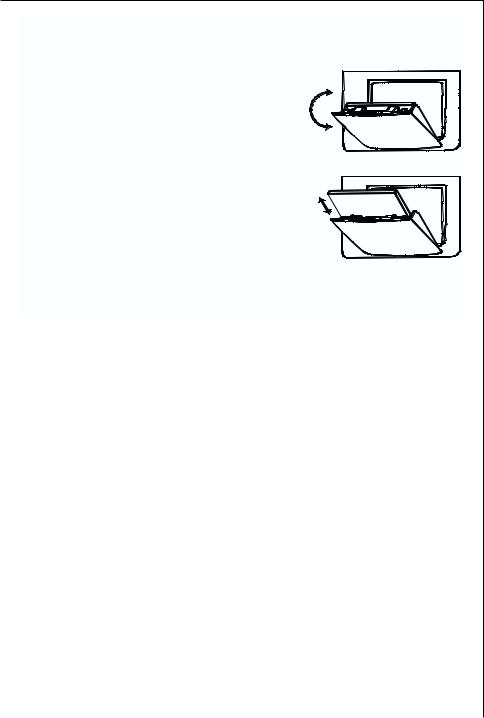
Changing the charcoal filter
To maintain the best performance the carbon filter should be changed every year.
1
New carbon filters can be pur-
chased from your local dealer.
1. The filter is placed behind the cover and can be reached by pulling the cover outwards. (1)
2.The carbon filter is then pulled out of its slot.
3.The new carbon filter is placed in the existing slot. Close the flap.
(2)
2 |
Note: the carbon filter is a consumable accessory and as such is not covered by the guarantee.
11

Starting Up - Setting the Temperature
1.Plug the mains plug into the mains socket.
2.Press ON/OFF button. The green mains pilot indicator illuminates. The appliances start.
3.Press either the „C“ or „E“ button. The temperature display switches over and the DESIRED temperature currently set flashes on the temperature display.
4.Set the required temperature by pressing the „C“ or „E“ buttons (see section "Temperature setting buttons"). The temperature display will immediately show the changed setting. Each time the button is pressed the temperature is adjusted by 1 °C.
From a food safety point of view +5 °C should be considered sufficiently cold for storing food in the fridge.
5.Once the required temperature has been set, after a short period (approx. 5 sec.) the temperature display will change and again indicate the current ACTUAL temperature inside the fridge. The display will change from flashing to continuous illumination.
Information! When the setting is changed, the compressor does not start immediately if automatic defrosting is currently taking place. As the storage temperature within the fridge is reached quickly you can store food immediately after switching on.
TURBOCOOLMATIC
The TURBOCOOLMATIC function is suited for quick cooling of large quantities of goods in the refrigerator.
1.The TURBOCOOLMATIC function is switched on by pressing the TURBOCOOLMATIC button. The yellow light illuminates.
The TURBOCOOLMATIC function now provides for intensive cooling. A DESIRED temperature of +3°C is automatically selected. The TURBOCOOLMATIC function is ended automatically after a period of 6 hours.
2.The TURBOCOOLMATIC function can be ended manually at any time by pressing the TURBOCOOLMATIC button again. The yellow light goes out.
12
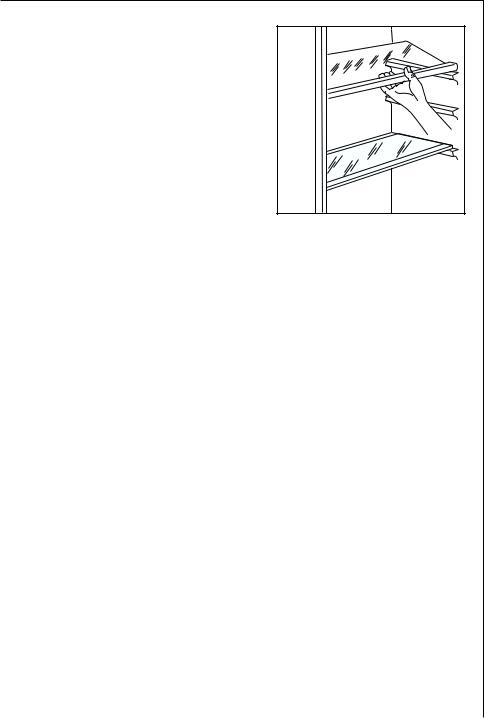
Interior Accessories
Storage Shelves
The glass shelf above the fruit and vegetable compartment should always remain in position, to ensure fruit and vegetables stay fresh longer.
The remaining storage shelves can be adjusted to various heights:
Pull the storage shelf forward until it
can be tipped up or down and remo- D338 ved.
To insert at a different height use the same procedure in reverse. Adjustment for tall goods:
Remove the front half of the two-part vario glass storage shelf and insert it at a different level. Space is thus gained for storage of tall goods on the underlying storage shelf.
Variable Inner Door
The door compartments can be pulled up and removed, and inserted at other positions as needed.
13
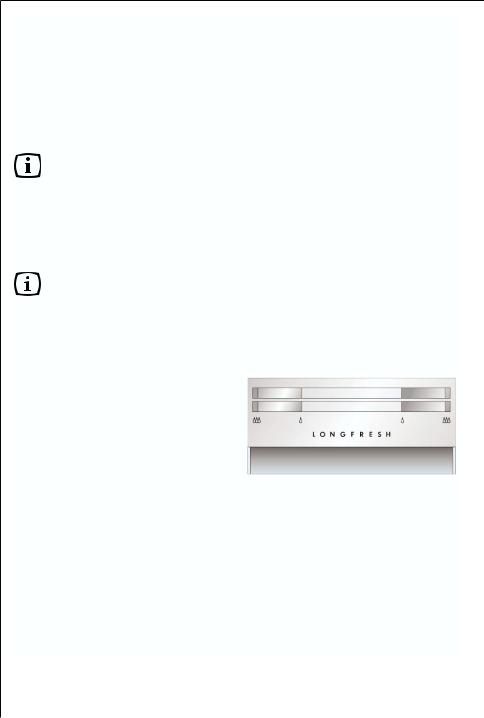
LONGFRESH 0°C compartment
In the LONGFRESH 0°C compartment the temperature is controlled automatically. It stays constantly at about 0°C, no adjustment is necessary.
The constant storage temperature of about 0°C and the relative humidity of between 45 and 90 % provide optimal conditions for the various kinds of food.
You can therefore store a variety of fresh food in the LONGFRESH 0°C compartment, where it will last up to 3 times longer with better quality compared to normal refrigerator compartments. This allows you to stock more fresh food. Taste, degree of freshness, quality and nutritional values (vitamins and minerals) are well preserved. Loss of weight in vegetables and fruit diminishes. Food yields a higher degree of nutritional value.
The LONGFRESH 0°C compartment is also suitable for defrosting food. In this case the thawed food can be stored up to two days in the LONGFRESH 0°C compartment.
Humidity control
Both drawers can be used according to the desired storage conditions independently of each other with lower or higher humidity.
Regulation for each drawer is separate and is controlled using the slide valve at the front of the drawer.
• „Dry“: low air humidity - up to 50 % relative humidity
This humidity level is reached when both sliders are set into this position  and the ventilation openings are wide open.
and the ventilation openings are wide open.
•„Humid“: high relative humidity - up to 90%
This humidity level is reached when both sliders are set in this posi-
tion  and the ventilation openings are closed. Humidity is kept and can not escape.
and the ventilation openings are closed. Humidity is kept and can not escape.
14
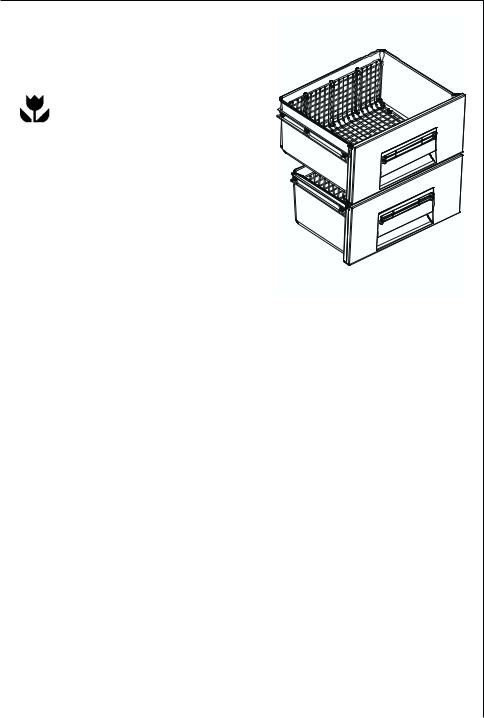
Drawer divider
The wire shelves inside the drawers permit that air can circulate freely and consequently a better conservation of foods.
The compartment has stops to prevent the drawers from falling out when fully extended.
To remove the drawers (e.g. for cleaning purposes), pull them out as far as the stops, lift and extract..
Note: if large quantities of foods are to be stored in the 0°C compartment, it is possible to remove the bottom drawer.
15

Correct storage
The refrigerator compartment is fitted with a fan. This quickly cools food stuffs and ensures optimal distribution of the temperature between the fridge and the LONGFRESH 0°C compartment.
The following can be conserved in the refrigeration compartment:
-beverages, preserves, jars, bottles;
-baked goods, prepared foods;
-products with short-term expiration;
-foods which are not suitable for conservation at the temperature of the LONGFRESH 0°C compartment.
Tips:
•Do not place warm foods or uncovered liquids in the refrigerator.
•Place foods in such a way that air can circulate freely and not place plastic bags or similar components in contact with the plastic cover grille situated in the fridge compartment.
•Keep butter and cheese in the special compartment to guarantee their consistency and aroma.
•Foods, and especially salad, must be kept in the refrigeration compartment well covered or packaged in such a way that they do not dry out and that their flavours and fragrances remain unchanged.
The following are suited for packaging:
–Polyethylene airtight bags and wraps;
–Plastic containers with lids;
–Special plastic covers with elastic;
–aluminium foil.
•High-proof spirits should only be conserved tightly closed and in a vertical position.
•Do not keep explosive or flammable materials in the refrigerator.
Conserve in the LONGFRESH 0°C compartment all foods which are suited to it.
Storage time in the LONGFRESH 0°C compartment for fresh food
Type of food |
|
Air humidity adjustment |
|
Storage time |
|
|
|
|
|
|
|
|
|
|
Onion |
|
“dry” |
|
up to 5 months |
|
|
|
|
|
|
|
|
|
|
|
|
|
|
|
Butter |
|
“dry” |
|
up to 1 month |
|
|
|
|
|
|
|
|
|
|
|
|
|
|
|
Large pork cuts |
|
“dry” |
|
up to 10 days |
|
|
|
|
|
|
|
|
|
|
16

|
Type of food |
|
|
Air humidity adjustment |
|
|
Storage time |
|
|
|
|
|
|
|
|
|
|
|
|
|
|
|
|
|
|
|
|
Beef, venison, small pork |
|
|
“dry” |
|
|
up to 7 days |
|
|
cuts, poultry |
|
|
|
|
|
||
|
|
|
|
|
|
|
||
|
|
|
|
|
|
|
|
|
|
|
|
|
|
|
|
|
|
|
Tomato sauce |
|
|
“dry” |
|
|
up to 4 days |
|
|
|
|
|
|
|
|
|
|
|
|
|
|
|
|
|
|
|
|
|
|
|
|
|
|
|
|
|
Fish, shellfish, cooked meat |
|
|
“dry” |
|
|
up to 3 days |
|
|
products |
|
|
|
|
|
||
|
|
|
|
|
|
|
||
|
|
|
|
|
|
|
|
|
|
|
|
|
|
|
|
|
|
|
Cooked seafood |
|
|
“dry” |
|
|
up to 2 days |
|
|
|
|
|
|
|
|
|
|
|
|
|
|
|
|
|
|
|
Salad, vegetables
Carrots, herbs, Brussels sprouts, celery
Artichokes, cauliflower, chicory, iceberg lettuce, endive, lamb’s lettuce, lettuce, leeks, radicchio
Broccoli, Chinese leaves, kale, cabbage, radishes, Savoy cabbage
Peas, kohlrabi
Spring onions, radishes, asparagus, spinach
Fruit (*)
Pears, dates (fresh), strawberries, peaches (*)
Plums (*), rhubarb, gooseberries
Apples (not sensitive to cold), quinces
Apricots, cherries
Damsons, grapes
 “humid”
“humid”
“humid”
“humid”
“humid”
“humid”
“humid”
“humid”
“humid”
“humid”
“humid”
up to 1 month
up to 21 days
up to 14 days
up to 10 days
up to 7 days
up to 1 month
up to 21 days
up to 20 days
up to 14 days
up to 10 days
(*) The riper the fruit, the shorter the storage time
17
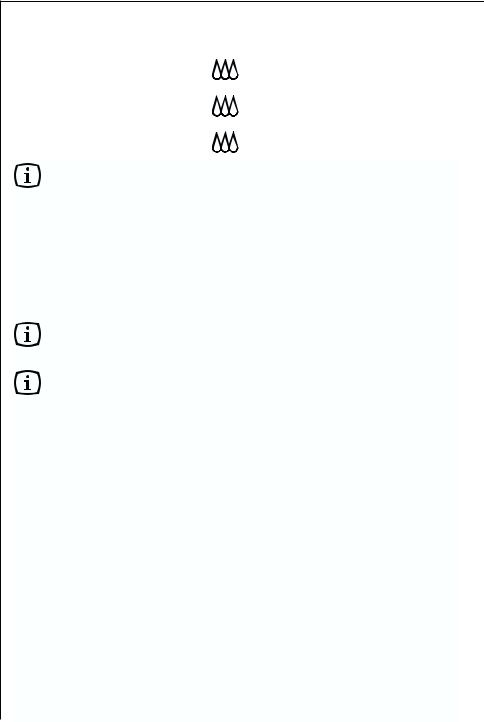
Type of food |
|
Air humidity adjustment |
|
Storage time |
|
|
|
|
|
|
|
|
|
|
Blackberries, currants |
|
“humid” |
|
up to 8 days |
|
|
|
|
|
|
|
|
|
|
|
|
|
|
|
Figs (fresh) |
|
“humid” |
|
up to 7 days |
|
|
|
|
|
|
|
|
|
|
|
|
|
|
|
Blueberries, raspberries |
|
“humid” |
|
up to 5 days |
|
|
|
|
|
|
|
|
|
|
Cakes containing cream and other kinds of pastry products can be stored in the LONGFRESH 0°C compartment for 2 or 3 days.
Important!
Not to be placed in the LONGFRESH 0°C compartment:
•cold sensitive fruit which have to be stored at cellar or room temperature like pineapple, bananas, grapefruit, melons, mango, papaya, oranges, lemons, kiwi fruit.
•The types of food not mentioned above should be stored in the refrigerator compartment (e.g. all sorts of cheese, cold cuts, etc.).
The level of air humidity in the drawers depends on the content of humidity in the stored food, vegetable and fruit and on the frequency of door opening
The LONGFRESH 0°C compartment is also suitable for slow thawing of food. In this case the thawed food can be stored in the LONGFRESH 0°C compartment for up to two days.
Tips:
•Pay attention to the freshness of the food, especially on the expiry date. Quality and freshness influence the storage time.
•The whole storage cycle time will depend on the preservation conditions made prior to the final storage in the fridge.
•Food, fruit or vegetables should always be packed or wrapped up before storage.
•Animal food always store packed and dry.
•Food rich in proteins will go bad quicker. This means seafood will spoil before fish which in turn will spoil before meat. While storing food in a 0°C compartment storage time for that kind of food can be increased by up to three times as well without loss on quality.
•All food stored in a 0°C compartment should be taken out of the drawers roughly 15-30 min before consumption, particularly fruit and vegetables to be consumed without any additional cooking process. Allowing fruit and vegetables to return to room temperature will improve the texture and flavour.
18

Switching off the appliance
To switch off, press the ON/OFF button for approx. 5 seconds. This will result in a countdown from "3" to "1" taking place in the temperature display. On reaching "1" the fridge will switch off. The temperature display will go off.
Note: The appliance cannot be switched on or off if unplugged, or if there is no power being supplied to it. Following connection to the mains power supply, the appliance returns to the same operating state as before the interruption of main power.
If the appliance is not going to be used for an extended period:
1.Remove all refrigerated packages.
2.Switch off the appliance by holding down the ON/OFF button until the display goes off (see above).
3.Remove the mains plug or switch off or disconnect from the electricity supply.
4.Clean thoroughly (see section “Cleaning and Care”).
5.Leave the doors open to avoid the build up of odours.
19

Operating and indicator panel freezer
|
TURBO |
|
|
|
°C |
|
|
|
|
°C |
°C |
|
°C |
|
|
|
|
ALARM OFF |
|
ON/OFF |
ON/OFF |
|
|
|
|
|
|
|
|
|
H |
I |
J |
K |
L |
M |
N |
O |
P |
H.Mains pilot indicator (green)
I.Freezer button ON/OFF
J.Temperature setting button (for warmer temperatures)
K.Temperature display
L.Temperature setting button (for colder temperatures)
M.FROSTMATIC function "on" indicator (yellow)
N.FROSTMATIC button
O.Alarm reset light
P.Alarm reset button
Temperature setting buttons
The temperature is adjusted using the „J“ and „L“ buttons. These buttons are connected to the temperature display.
•The temperature display is switched over from the display of the ACTUAL temperature (Temperature display is illuminated) to the display of the DESIRED temperature (Temperature display flashes) by pressing one of the two buttons, „J“ or „L“).
•Each time one of the two buttons is pressed again the DESIRED temperature is adjusted by 1 °C. The DESIRED temperature must be reached within 24 hours.
If neither button is pressed, the temperature display automatically switches back after a short period (approx. 5 sec.) to the display of the ACTUAL temperature.
20

DESIRED temperature means:
The temperature that has been selected for inside the freezer. The DESIRED temperature is indicated by flashing numbers.
ACTUAL temperature means:
The temperature display indicates the current temperature inside the freezer. The ACTUAL temperature is indicated with illuminated numbers.
Temperature display
The temperature display can indicate several pieces of information.
•During normal operation, the temperature currently present in the freezer (ACTUAL temperature) is displayed.
•When the temperature is being adjusted a flashing display indicates the freezer temperature currently set (DESIRED temperature).
Starting Up - Setting the Temperature
1.Plug the mains plug into the mains socket.
2.Press ON/OFF button. The green mains pilot indicator illuminates. The alarm light flashes since the temperature is reached. The buzzer sounds.
3.Pressing button “P” the buzzer stops.
4.Press either the „J“ or „L“ button. The temperature display switches over and the DESIRED temperature currently set flashes on the temperature display.
5.Set the required temperature by pressing the „J“ or „L“ buttons (see section "Temperature setting buttons"). The temperature display will immediately show the changed setting. Each time the button is pressed the temperature is adjusted by 1 °C.
From a food safety point of view -18 °C should be considered sufficiently cold for storing food in the freezer.
6.The alarm light,when the set temperature is reached. Press the alarm button to turn off the buzzer.
Ice packs
There are two ice packs in one drawer of the freezer.
In the event of a power failure or malfunction, the ice pack will lengthen the amount of time it takes for the frozen food to become too warm by several hours. The ice pack can only fulfil this task optimally if it is placed in the uppermost drawer, at the front, above the frozen food. You can use the ice pack for cooling cold bags.
21

FROSTMATIC
The FROSTMATIC function accelerates the freezing of fresh food and, at the same time, protects foodstuffs already stored from undesirable warming.
1.The FROSTMATIC function is switched on by pressing the FROSTMATIC button. The yellow light illuminates.
If the FROSTMATIC function is not ended manually, the appliance switch off the FROSTMATIC function after 48 hours. The yellow light goes out.
2.The FROSTMATIC function can be ended manually at any time by pressing the FROSTMATIC button again. The yellow light goes out.
Alarm reset button
In the event of an abnormal temperature rise inside the freezer (e.g. power cut) warning light (O) will start to flash and a buzzer will sound.
After the temperature has returned to normal, the warning light (O) will continue to flash, although the buzzer has stopped.
When the alarm button is pressed, the warmest temperature reached in the compartment flashes on the indicator.
Switching the Appliance off
To switch off, hold down the ON/OFF button for approx. 5 seconds. This will result in a countdown from "3" to "1" taking place in the temperature display. On reaching "1" the fridge will switch off. The temperature display will go off.
Note:
The appliance cannot be switched on or off if unplugged, or if there is no power being supplied to it. Following connection to the mains power supply, the appliance returns to the same operating state as before the interruption of main power.
If the appliance is not going to be used for an extended period:
1.Switch off the appliance, holding down the ON/OFF button until the display goes off (see above).
2.Remove the mains plug or switch off or turn out the circuit breaker or fuse.
3.Defrost the freezer compartment and clean the appliance thoroughly (see section: “Cleaning and Maintenance”).
4.Finally, leave the doors open so as to avoid a build up of odours.
22

Freezing and storing frozen food
You can use your freezer for freezing fresh food yourself.
Important!
•The temperature in the freezer compartment must be –18 °C or colder before freezing food.
•Please observe the freezing capacity given on the rating plate. The freezing capacity is the maximum quantity of fresh food that can be frozen within a period of 24 hours. If you wish to freeze food several days in a row, please observe a maximum capacity of only 2/3 to 3/4 of that on the rating plate. The quality of the food is best preserved when it is frozen right through to the core as quickly as possible.
•Allow warm food to cool down before freezing. The warmth will cause increased ice formation and increase the power consumption.
•Please note the maximum storage times specified by the manufacturer.
•Thawed foods which have not been processed further (cooked into meals) may not under any circumstances be frozen a second time.
•Containers with flammable gases or liquids can leak at low temperatures. There is a risk of an explosion! Do not store any containers with flammable materials such as, for example, spray cans, fire extinguisher refill cartridges etc in the refrigerator/freezer.
•Bottles and cans must not be placed in the freezer. They can burst when the contents freeze, high carbonate content drinks can even explode! Never store lemonade, juices, beer, wine, sparkling wine etc. in the freezer. Exception: high alcohol content spirits can be stored in the freezer.
•All foods must be packed air tight prior to freezing, so that they do not dry out or lose their flavour, and so that no flavour contamination of other frozen goods occurs.
Caution! Do not touch frozen food with wet hands. Your hands could freeze to the food.
1.Place the packed food in the drawers. Place food to be frozen in the upper compartment. Unfrozen food must not touch items already frozen, otherwise the frozen food could begin to defrost.
2.Place frozen foods in the drawers sorted by type, as far as possible.
23
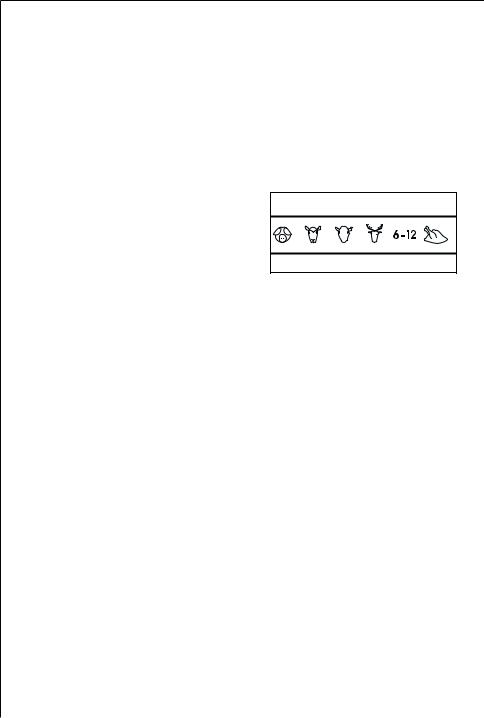
Preparation of Ice Cubes
1.Fill the ice cube tray 3/4 full with cold water, place it in the freezer compartment and leave to freeze.
2.To loosen the frozen cubes, either bend the ice cube tray or hold it under running water for a few seconds.
Important! Never try to free an ice tray that is frozen to the freezer compartment using pointed or sharp edged objects. Use the ice scraper supplied.
Freezing Calendar
• The symbols on the drawers show different types of frozen goods.
•The numbers indicate storage times in months for the appropriate types of frozen goods.
Whether the upper or lower value of the indicated storage time is valid depends on the quality of the foods and pre-treating before freezing. The lower value applies to foods with high fat content.
Defrosting
The fridge defrosts automatically
Defrosting of the fridge compartment is automatic. The water that forms flows into a recipient on the compressor and evaporates. This recipient cannot be removed.
Freezer
The freezer compartment, however, will become progrssively covered with frost. This should be removed with the special plastic scraper provided, whenever the tickness of the frost exceeds 4 mm. During this operation it is not necessary to switch off the power supply or to remove the foodstuffs.
However when the ice becomes very thick on the inner liner, complete defrosting should be carried out as follows:
1.Remove the frozen food from the freezer, wrap it in several layers of newspaper and put it in a very cool place.
2.Switch off the appliance and pull out the plug, or remove or unscrew the safety fuses.
3.Leave the freezer compartment door open.
24

4.Insert the plastic scraper into the recess provided under the defrost water channel and place a collecting basin under it.
5.Once defrosting is completed keep the scraper for future use;
6.Switch on the appliance or replace the plug in the power socket.
Warning!
Never use metal tools to scrape off the frost
D068 |
Do not use a mechanical device or any artificial means to speed up the thawing process other than those recommended by the manufacturer.
A temperature rise of the frozen food packs, during defrosting , may shorten their safe storage life.
Cleaning and Care
For hygienic reasons the appliance interior, including interior accessories, should be cleaned regularly.
Warning!
•The appliance may not be connected to the mains during cleaning. Danger of electrical shock! Before cleaning switch the appliance offand rem ve the plug from the mains, or switch off or turn out the circuit breaker or fuse.
•Never clean the appliance with a steam cleaner. Moisture could accumulate in electrical components, danger of electrical shock! Hot vapours can lead to the damage of plastic parts.
•The appliance must be dry before it is placed back into service.
Attention!
•Ethereal oils and organic solvents can attack plastic parts, e.g.
–lemon juice or the juice from orange peals;
–butyric acid;
–cleansers which contain acetic acid.
Do not allow such substances to come into contact with appliance parts.
• Do not use any abrasive cleansers.
1.Remove frozen food and the food from the refrigerator. Wrap frozen food in several layers of newspaper. Store it in a cool place, well covered.
25

2.Defrost the freezer compartment prior to cleaning (see "Defrosting" section).
3.Switch the appliance off and remove the plug from the mains, or switch off or turn out the circuit breaker or fuse.
4.Clean the appliance and the interior accessories with a cloth and lukewarm water. Commercially available dish washing detergents may also be used.
5.After cleaning wipe with fresh water and rub dry.
Accumulation of dust at the condenser increases energy consumption. For this reason carefully clean the condenser at the back of the appliance once a year with a soft brush or a vacuum cleaner.
6.After everything is dry reconnect the appliance to the electricity supply.
The lowest shelf, dividing the cooler compartment from the LONGFRESH 0°C compartment can be removed for cleaning. To remove pull out the shelf straight.
The cover plates above the drawers in the 0°C compartment can be taken out for cleaning. To make sure fully functionality of the LONGFRESH 0°C compartment the cover must be put back in their original position after cleaning.
 Energy Saving Tips
Energy Saving Tips
•Do not install the appliance near cookers, radiators or other sources of warmth. High ambient temperatures cause longer, more frequent operation of the compressor.
•Ensure sufficient air circulation and exhaust at the appliance base and at the back wall of the appliance. Never cover air vent openings.
•Do not place warm foods into the appliance. Allow warm foods to cool first.
•Only leave door open as long as necessary.
•Do not set temperature any colder than necessary.
•Put frozen food in the fridge to defrost. The cold in the frozen food will then be used to cool the fridge.
•Keep the heat emitting condenser, the metall grille on the rear wall of your appliance, always clean.
26
